Harmsworth 86 Homebush Road, Strathfield
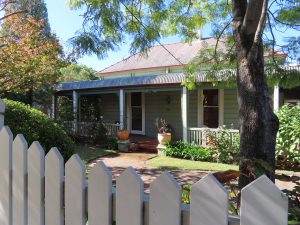
Harmsworth, 86 Homebush Road, Strathfield, May 2023. Courtesy Strathfield Local Studies
The Victorian cottage, Harmsworth, at 86 (formerly 60) Homebush Road, Strathfield was built during the early to mid 1890s. Unusually for a Strathfield home of this age it was built of weatherboard with a symmetrical façade and a slate hip roof with terracotta capping. The ‘return verandah has a corrugated iron bull nosed roof, square timber posts, timber balustrade and timber flooring.’[1] It is significant for its architectural qualities, illustrating the range of early housing in Strathfield.
Google maps show that the white picket fence was added in 2013.
Harmsworth has been home to a number of prominent residents over the years. It was first occupied by Robert Bliss Wilkinson JP, stock and station agent and the former NSW MP for Balranald from 1880 to 1894. Wilkinson did not stay long at Harmsworth, although he remained in the Strathfield district, dying aged 90 at his home, Wilga in The Boulevarde in April 1928.[2]
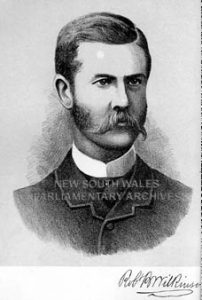
Robert Bliss Wilkinson. Courtesy NSW Parliament.
By 1900, however Harmsworth was occupied by Francis Sheriff Isaacs, stipendiary magistrate. He was born in Antigua in 1847 and was the son of barrister and politician, Robert McIntosh Isaacs.[3] Sadly, his wife Margaret died at Harmsworth in late July 1900.[4]
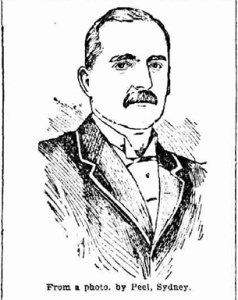
Francis Sheriff Isaacs. Daily Telegraph 22 June 1896 p.5
In December 1903 Harmsworth was offered at auction, by order of the mortgagee. ‘The grounds are neatly laid out in lawns, and flowers and fruit cultivated, and comprise an area of 3 roods 16 perches, having frontages of 224 ft to Homebush Road, 166 ft to Alviston Street, and 165 ft to Redmyre Street.’
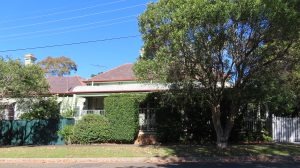
Harmsworth, May 2023 from Redmyre Road. Courtesy Strathfield Local Studies
‘Harmsworth is substantially built and attractively finished, of weatherboard, lath and plaster, and wood lined inside, on brick foundation, slated roof, with verandahs front and side, and enclosed verandah at rear, and containing drawing and dining rooms, 3 bedrooms, servants’ bedroom, bathroom, pantry, kitchen, and laundry, detached stable and 2 rooms attached, large storeroom at rear.’[5]
The contents of the home were offered at auction on 22 April 1904 on behalf of Francis S. Isaacs Esq. ‘on account of his projected visit to England.’[6] The contents included ‘a magnificent Lipp pianoforte… beautiful drawing room furnishings,’ walnut furniture, dinner services, artworks, clocks and kitchen equipment, as well as garden tools, carpet and even linoleum.
In August 1905 the wife of Arthur R. Marks gave birth to a son at Harmsworth.[7]
By 1905 Charles E. Robinson was in residence at Harmsworth – but he didn’t stay long either. In October 1908 Robinson offered most of his household possessions for auction on site. These included a ‘magnificent solid oak dwarf bookcase, formerly the property of late Judge Windeyer… handsome bedsteads and best bedding … [and] first-class poultry.’[8]
The occupant in 1909 was a J. Green who may have been a property agent as he offered land in Waitara and a shop in Chatswood for sale in December that year, giving his address as Harmsworth.[9]
He was followed – briefly – by Thomas R. Roydhouse in 1910, editor of the Sunday Times. Again, Roydhouse remained local, dying in Homebush, aged 80, in 1943.
By late 1911 the Harrison family was in residence when Dr E. Selwyn Harrison, the son of G.R. Harrison of Harmsworth, was married to Miss Elsie Besnard of Yass.[10] The Harrisons were still in residence in 1913 when another son, Leslie was married that December.[11] George Harrison died suddenly at Harmsworth the following year, aged 83.[12]
The Harmsworth Estate was subdivided and offered for sale during 1918 as ‘5 splendid building sites, with the villa residence on Lot 1, known as “Harmsworth.”’[13]
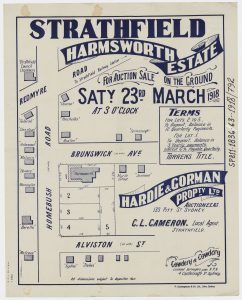
Harmsworth Estate, 1918. Courtesy State Library of NSW
During August 1919 the wife of Andrew Town gave birth to a daughter at Harmsworth.[14] It appears the infant, Alice survived only a day.[15]
Harmsworth was again offered for sale in July 1920.[16] Sands’ Street Index shows that in 1920 the house was occupied by Andrew Town.
Valuation records for 1924 show that the property was then owned by Walter Brown, builder. He must have offered the cottage for sale late that year as he withdrew it from sale during January 1925.[17]
Interestingly, by 1930 the Misses S. & N. Watson were running a preparatory school on site.[18] Known as Avoca Preparatory School, the school was later situated in Albert Road. In 1940 a Miss Willison of 60 Homebush Road Strathfield submitted her recipe for cocktail jam to Truth.[19]
Valuation records show that Walter Brown remained the owner of Harmsworth until World War II, although he did not reside in the property, living nearby in Beresford Road instead. He died in 1955.
Harmsworth was purchased by Daniel Purdy Horwood Jr, an accountant, who lived in the house for a few years from about 1943 until about 1949. The site was subdivided further during the late 1940s. By about 1950 the house was owned by Herbert Dawes and Enid Brooks and later by William and Peggy Etchell. During the 1960s it was owned by Edna Calder.
Harmsworth is listed on the Strathfield Local Environmental Plan of 2012.
The West Sydney Chinese Christian Church now occupies part of the Harmsworth Estate on the corner of Alviston Street. The building was formerly the Strathfield Presbyterian Church, built in 1921.[20]
By J J MacRitchie
Local Studies Advisor
References
[1] Strathfield Heritage Study, 1986[2] The Riverine Grazier 1 May 1928 p.2 https://trove.nla.gov.au/newspaper/article/140675606
[3] Mudgee Guardian and North-Western Representative 2 November 1905 p.4 https://trove.nla.gov.au/newspaper/article/157683461
[4] Sydney Morning Herald 1 August 1900 p.1 https://trove.nla.gov.au/newspaper/article/14327568
[5] Sydney Morning Herald 5 December 1903 p.19 http://trove.nla.gov.au/newspaper/article/14584429
[6] Sydney Morning Herald 21 April 1904 p.3 http://trove.nla.gov.au/newspaper/article/14614626
[7] Sydney Morning Herald 12 August 1905 p.10 https://trove.nla.gov.au/newspaper/article/14721294
[8] Sydney Morning Herald 13 October 1908 p.3 http://trove.nla.gov.au/newspaper/article/15003908
[9] Sydney Morning Herald 8 December 1909 p.3 http://trove.nla.gov.au/newspaper/article/15106290
[10] Punch (Melbourne) 14 December 1911 p.31 https://trove.nla.gov.au/newspaper/article/177535220
[11] Sunday Times 7 December 1913 p.9 https://trove.nla.gov.au/newspaper/article/126310553
[12] Sydney Morning Herald 24 August 1914 p.4 https://trove.nla.gov.au/newspaper/article/239071255
[13] Daily Telegraph 22 March 1918 p.16 http://trove.nla.gov.au/newspaper/article/239251899
[14] Sydney Morning Herald 27 August 1919 p.10 https://trove.nla.gov.au/newspaper/article/15851491
[15] Sydney Morning Herald 27 August 1919 p.10 https://trove.nla.gov.au/newspaper/article/15851491
[16] Sydney Morning Herald 21 July 1920 p.4 http://trove.nla.gov.au/newspaper/article/15898640
[17] Sydney Morning Herald 30 January 1925 p.4 https://trove.nla.gov.au/newspaper/article/16195740
[18] Sands Street Index, 1930
[19] Truth 21 April 1940 p.34 https://trove.nla.gov.au/newspaper/article/169102648
[20] Jones, Cathy ‘Former Presbyterian Church, 90 Homebush Rd’ https://strathfieldheritage.com/streetnames/homebush-road-strathfield/former-presbyterian-church-90-homebush-rd/

1 Comment. Leave new
Thank you. I have long admired that house.